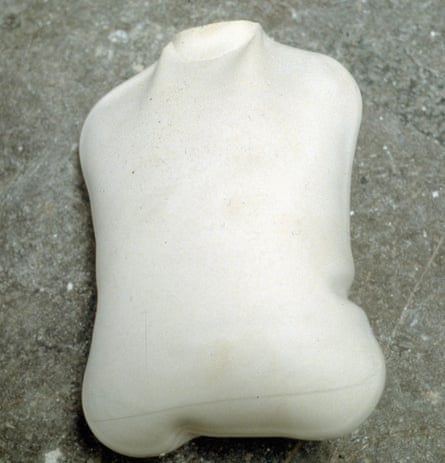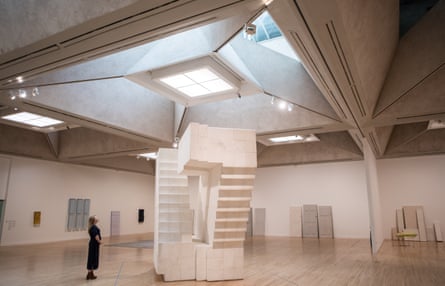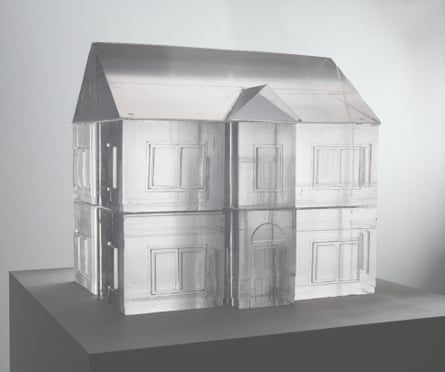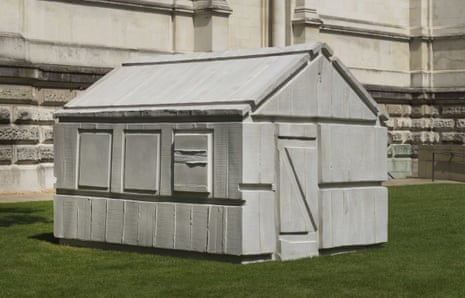There is a small white shack on the lawn in front of Tate Britain. It looks exactly like the very thing it is, namely the concrete cast of a chicken shed. The windows are blind and the door could never open to let the birds out, for the object is a solid block, heavy and impenetrable, unlike the airy structure it repeats. And yet it is still, first and last, a chicken shed.
Or is it? The art of Rachel Whiteread turns things inside out. This piece – hailed as a major new work at Tate Britain, though it’s anything but, and the artist calls it “shy” – is a cast of the space inside the shed. There’s a clue in the fact that the window frames are indented, instead of standing out. But so what? The object on the lawn – literal, stolid, untranslated – retains the form of the shed. It is a sculptural tautology.
Whiteread (born 1963) has been casting these so-called “negatives spaces” for three decades. The original idea comes from the US artist Bruce Nauman, whose A Cast of the Space Under My Chair (1965-8) spells out the method, if not the varying effects. Whiteread has gone further, casting the innards of a hot-water bottle and a mattress; the undersides of a table, the space behind a fireplace or surrounding a bath. Her works run from the modest to the monumental – most famously the interior of an entire house – cast in plaster, resin, concrete or rubber, occasionally in metal (mundane) and lately in papier-mache (actively hideous). Everything she makes balances the possibility of poetry against the risk of banality.

This is not necessarily intrinsic to the objects themselves. Take the beautiful piece Torso that opens this enormous exhibition. Cast in plaster, from a hot-water bottle, this little thing lies on its back, vulnerable, pale and turning slightly, as if troubled in sleep. Whiteread made this sculpture in 1988, and it remains unsurpassed. One can say this because the artist has been casting hot water bottles ever since. There are nine more in this show – in clear resin, yellow wax, flesh-pink plaster, each differently swollen or flexed. Not one has the same potency or charge.
It is the same with the mattresses. Some look precisely like mattresses; others appear less familiar; most are propped against the wall. But Shallow Breath is slightly slumped, as if exhausted, or trying its best to inhale and exhale in the midnight hours. There is, in short, a marvellous analogy between the original object, the sculptural form and the title. And all the nuances of solitude and anxiety are carried without any resort to the anthropomorphic.
There is a spellbinding quietude to these early works. People still go on tiptoe to look into the kitchen sink, as if there might something stirring there. Closet – the cast of a wardrobe covered in black felt – still makes the childhood fear of such interior darkness both visible and solid. Cell, her cast of a grate and the space behind it, goes to the quick of one’s curiosity about the secret world behind the fireplace. And the towering white plaster Untitled (Stairs), from 2001, zooms up and down to nowhere, with overtones of Piranesi and Escher, like the flights of steps in trapped dreams.

That whiteness has become Whiteread’s own trademark somewhat. It diverts attention from the original object, emphasising the status of these works as sculptures. A cardboard box, a bath, a sink – cast in white plaster or concrete, all lose their individuality to become universal forms, and perhaps even quasi-abstract. There is a work here called Untitled (White Slab), and its provenance is completely unclear. It looks far more like a work of American minimalism than any kind of household object.
Whiteread’s debt to America is everywhere obvious, especially to Bruce Nauman, Donald Judd and Carl Andre, whose bricks have their echoes in her many casts of floors – floors that precisely resemble floors. And here is an obvious division in her work. Some casts produce recognisable facsimiles; the space around a bath, when cast, produces another bath. But the one hundred casts of spaces beneath assorted chairs, made in glowing coloured resins, translucent as Pears soap, do not evoke chairs. Some look like tiny telephone boxes, others like miniature cenotaphs or tower blocks. Stretching away into the distance, they suggest a whole metropolis of small buildings. The emphasis is architectural rather than human.
That can feel obdurate, and even chilling, especially in the largest works. In 2003, Whiteread cast the interior space of Room 101 at the BBC’s Broadcasting House, supposedly the inspiration for the torture chamber in George Orwell’s Nineteen Eighty-Four. The colossal white block, with no point of entry or exit, is a properly ominous presence in this show. But then a nearby collection of cardboard boxes yields nothing more interesting than a dozen white blocks, ribbed with corrugations if you care to look closely for the purposes of identification; the arrangement feels arbitrary, the concept (whatever it might have been) is lost.

The interior walls have been removed at Tate Britain to create a single gallery the size of an aircraft hangar. This means that every work has exactly the same context. Without natural lighting, some of the transparent doors lose their lovely volatility. Without smaller spaces, some of the more modest pieces struggle to speak. Shown all together, what’s more, Whiteread’s work starts to look almost obsessively neat and over-determined, nothing whatsoever left to chance.
Which may simply be the nature of her modus operandi, of course. Cast the inside of a box and you get a cube that looks just like a box; cast the inside of a can and you get a cylinder. Geometric forms inevitably predominate. But when she presents loo rolls in tidy lines, or coke cans on shelves, or wallpaper rolls on chairs, they appear both trivial and wilfully domestic.
Whiteread works in series, as this show makes clear. Replication can border on repetition; facsimile, no matter in what medium, colour, configuration or scale, doesn’t always lead to transformation. But when these elements are in perfect alignment, she is a poet of the past. This was the case with House in 1993, that pale ghost of a building commemorating the lives of its lost East End inhabitants; in the translucent Water Tower (1998) high up in the SoHo skyline, that became a monument to New York’s vanishing history; and in the celebrated Holocaust Memorial (2000), a library turned inside out, in the centre of Vienna’s Judenplatz.
In this show, curiously, the strongest building is the smallest: a cast of a doll’s house made out of glass. It is a wonderful sight, ghostly and gleaming, like a miniature palace of ice. And as if fulfilling some childhood fantasy, you can see right through the walls into every room, even when the doors are closed – looking down translucent corridors into all these shining chambers of the mind.


Comments (…)
Sign in or create your Guardian account to join the discussion